Abstract
The responses of common purslane (Portulaca oleracea L.) plants to 2-methoxy-3,6-dichlorobenzoic acid (dicamba) were found to be similar in many respects to ethylene fumigation effects. Dicamba and ethylene increased the permeability of cell membranes in purslane tissues. An increased efflux of electrolytes was observed in the bending region of the stems of dicamba-treated plants. Epinastic leaves after dicamba (10 micrograms) and ethylene (microliter per liter) treatments showed an increased efflux of rubidium. The permeability effects were observable within 1 day after dicamba or ethylene application. Protein metabolism in purslane leaves was not influenced by dicamba until 2 days after treatment, as indicated by reduced nitrate reductase activity. Inhibition of phenylalanine-U-14C incorporation into protein was observed 3 days after treatment. Ethylene reduced both phenylalanine-U-14C incorporation into protein and nitrate reductase activity within 1 day. Dicamba caused a rapid increase in ethylene production in purslane plants to levels many times greater than those observed in untreated plants. It was concluded that the dicamba-enhanced production of ethylene is responsible for many of the observed effects of the herbicide.
Full text
PDF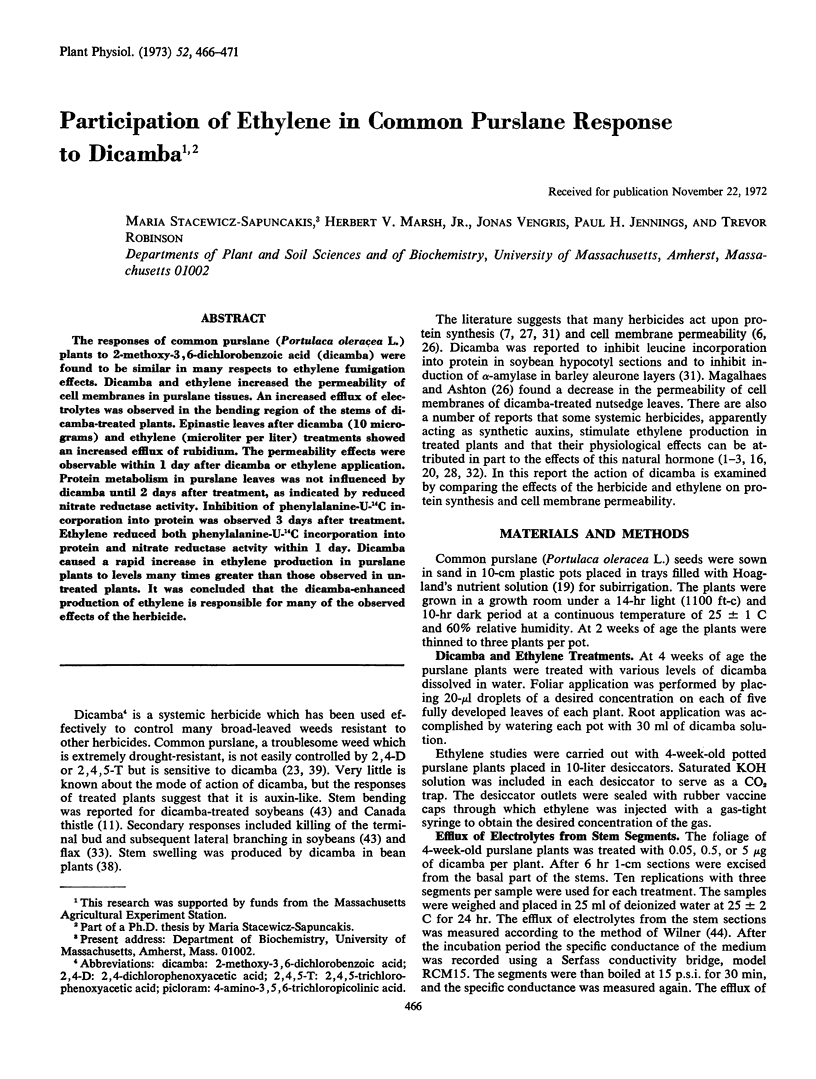
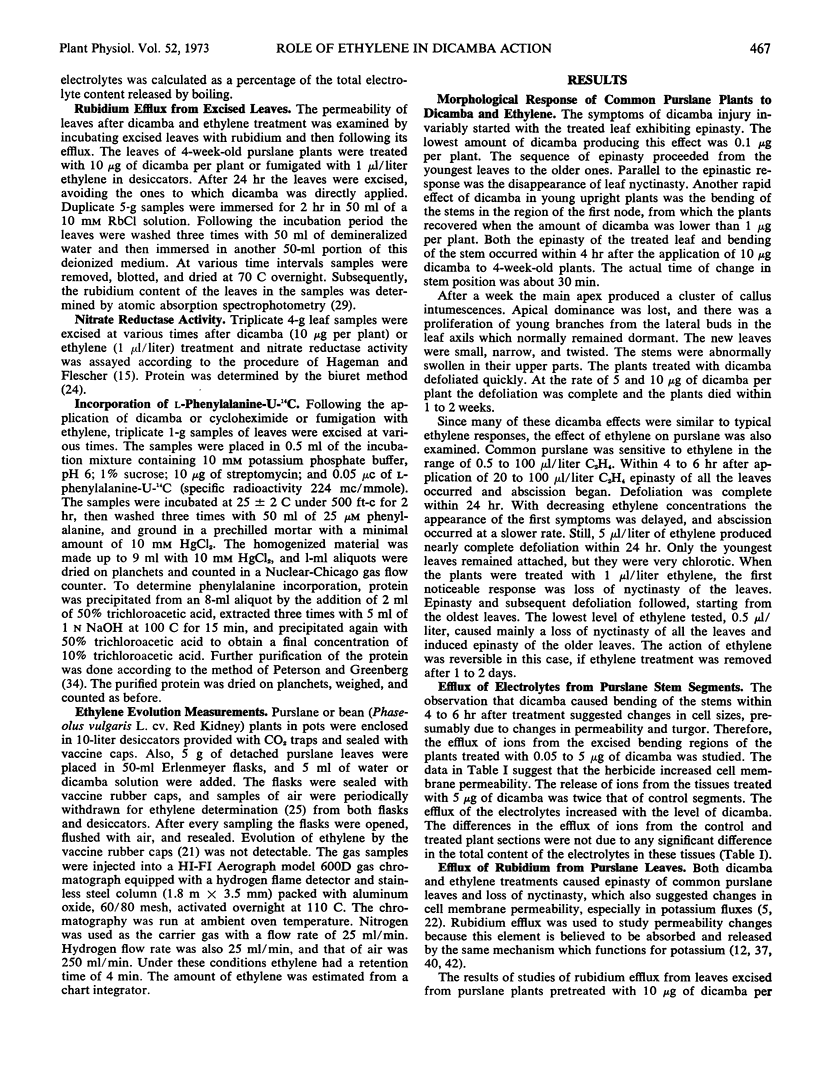
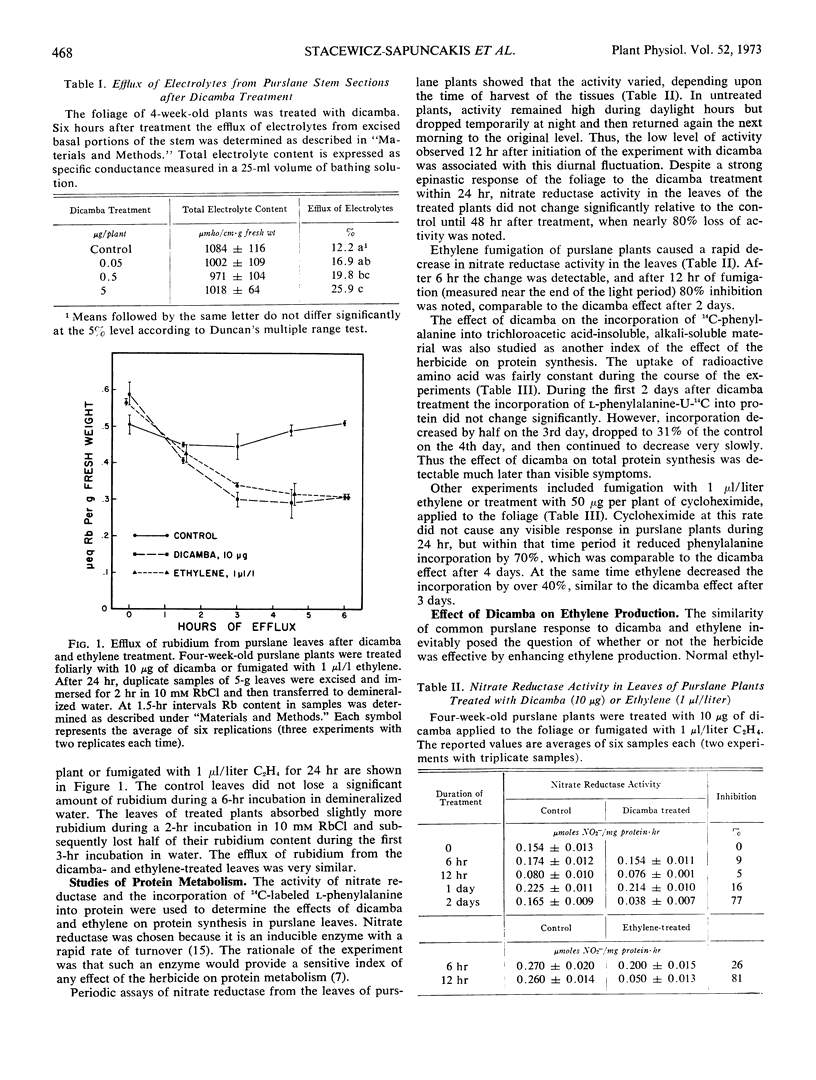
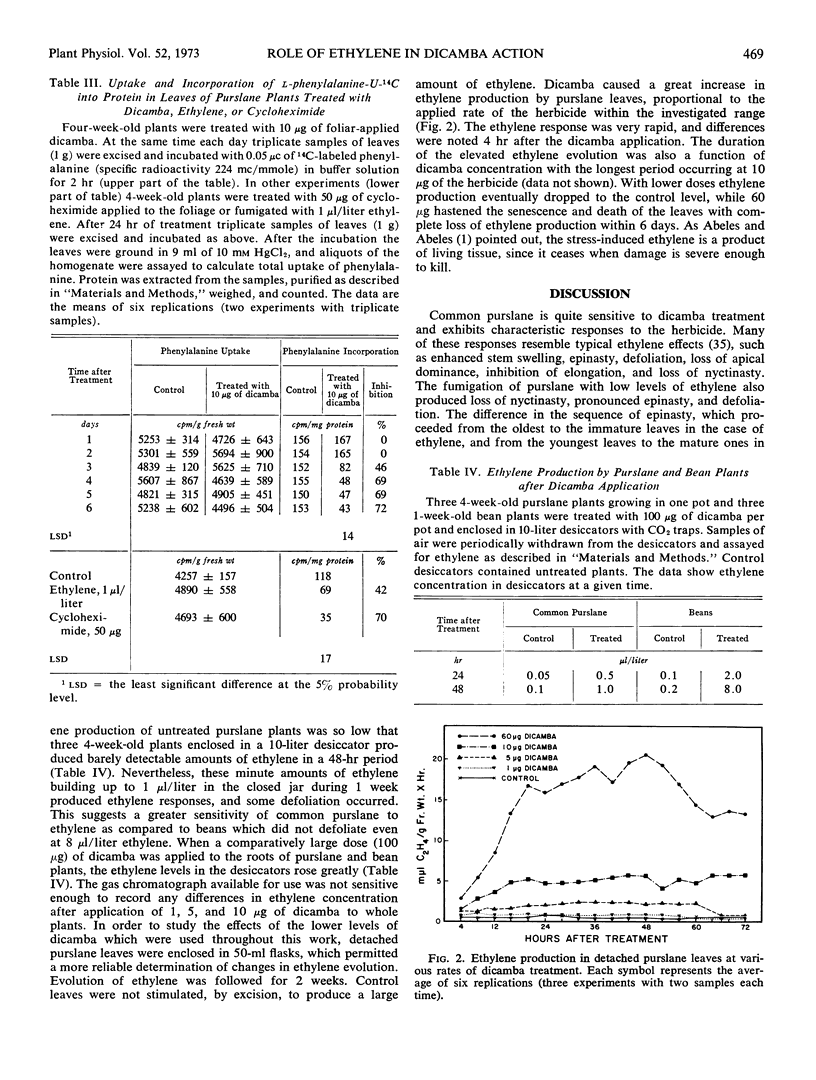
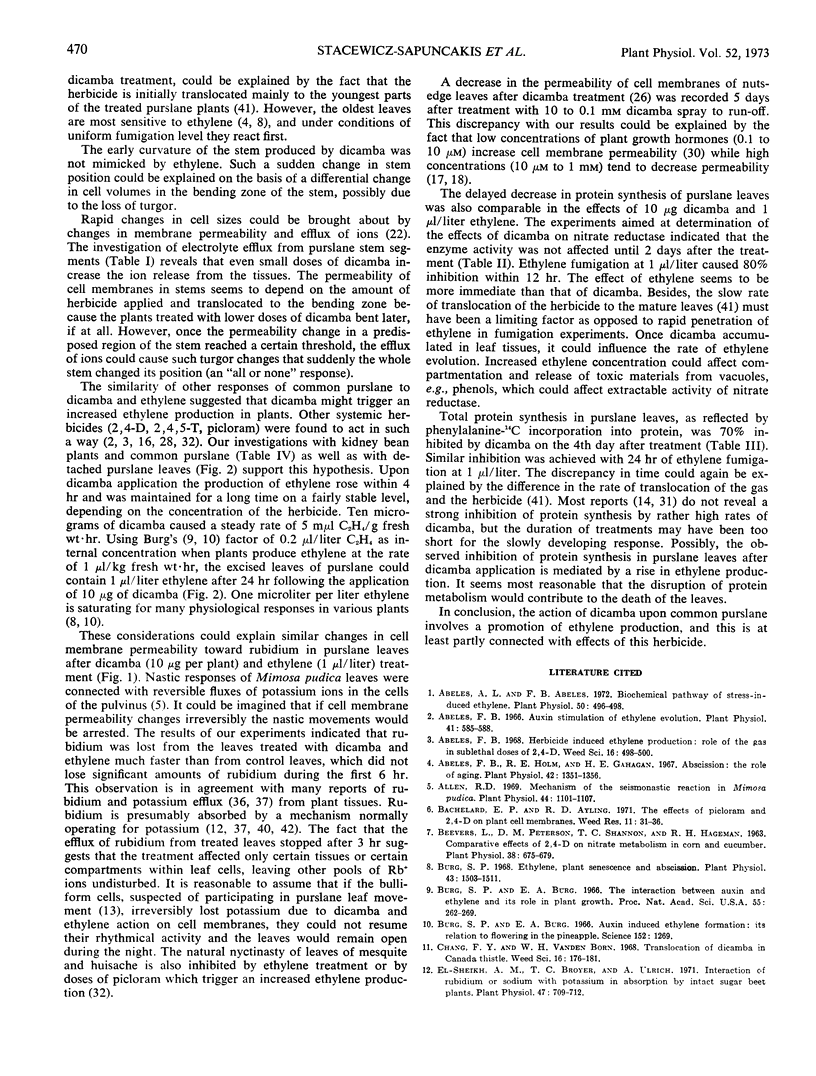
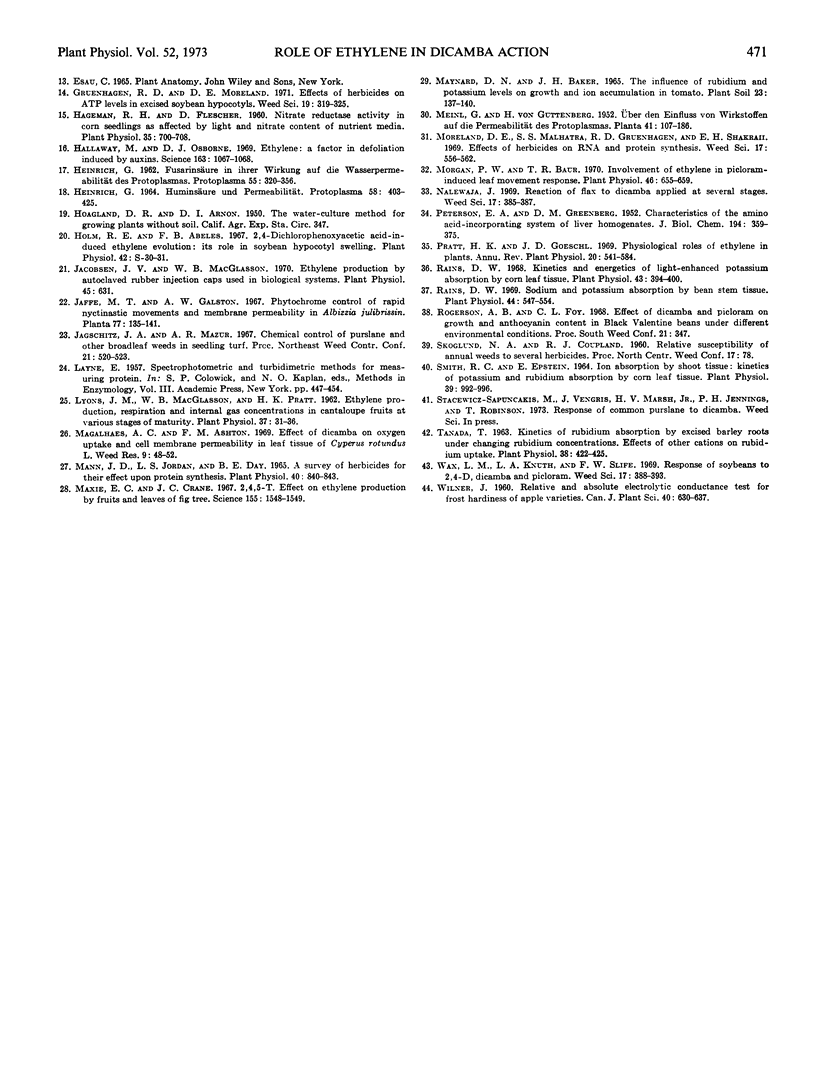
Selected References
These references are in PubMed. This may not be the complete list of references from this article.
- Abeles A. L. Biochemical Pathway of Stress-induced Ethylene. Plant Physiol. 1972 Oct;50(4):496–498. doi: 10.1104/pp.50.4.496. [DOI] [PMC free article] [PubMed] [Google Scholar]
- Abeles F. B. Auxin stimulation of ethylene evolution. Plant Physiol. 1966 Apr;41(4):585–588. doi: 10.1104/pp.41.4.585. [DOI] [PMC free article] [PubMed] [Google Scholar]
- Abeles F. B., Holm R. E., Gahagan H. E. Abscission: the role of aging. Plant Physiol. 1967 Oct;42(10):1351–1356. doi: 10.1104/pp.42.10.1351. [DOI] [PMC free article] [PubMed] [Google Scholar]
- Allen R. D. Mechanism of the Seismonastic Reaction in Mimosa pudica. Plant Physiol. 1969 Aug;44(8):1101–1107. doi: 10.1104/pp.44.8.1101. [DOI] [PMC free article] [PubMed] [Google Scholar]
- Beevers L., Peterson D. M., Shannon J. C., Hageman R. H. Comparative Effects of 2,4-Dichlorophenoxyacetic Acid on Nitrate Metabolism in Corn and Cucumber. Plant Physiol. 1963 Nov;38(6):675–679. doi: 10.1104/pp.38.6.675. [DOI] [PMC free article] [PubMed] [Google Scholar]
- Burg S. P., Burg E. A. Auxin-induced ethylene formation: its relation to flowering in the pineapple. Science. 1966 May 27;152(3726):1269–1269. doi: 10.1126/science.152.3726.1269. [DOI] [PubMed] [Google Scholar]
- Burg S. P., Burg E. A. The interaction between auxin and ethylene and its role in plant growth. Proc Natl Acad Sci U S A. 1966 Feb;55(2):262–269. doi: 10.1073/pnas.55.2.262. [DOI] [PMC free article] [PubMed] [Google Scholar]
- Burg S. P. Ethylene, plant senescence and abscission. Plant Physiol. 1968 Sep;43(9 Pt B):1503–1511. [PMC free article] [PubMed] [Google Scholar]
- El-Sheikh A. M., Broyer T. C., Ulrich A. Interaction of rubidium or sodium with potassium in absorption by intact sugar beet plants. Plant Physiol. 1971 May;47(5):709–712. doi: 10.1104/pp.47.5.709. [DOI] [PMC free article] [PubMed] [Google Scholar]
- Hageman R. H., Flesher D. Nitrate Reductase Activity in Corn Seedlings as Affected by Light and Nitrate Content of Nutrient Media. Plant Physiol. 1960 Sep;35(5):700–708. doi: 10.1104/pp.35.5.700. [DOI] [PMC free article] [PubMed] [Google Scholar]
- Hallaway M., Osborne D. J. Ethylene: a factor in defoliation induced by auxins. Science. 1969 Mar 7;163(3871):1067–1068. doi: 10.1126/science.163.3871.1067. [DOI] [PubMed] [Google Scholar]
- Jacobsen J. V., McGlasson W. B. Ethylene production by autoclaved rubber injection caps used in biological systems. Plant Physiol. 1970 May;45(5):631–631. doi: 10.1104/pp.45.5.631. [DOI] [PMC free article] [PubMed] [Google Scholar]
- Lyons J. M., McGlasson W. B., Pratt H. K. Ethylene Production, Respiration, & Internal Gas Concentrations in Cantaloupe Fruits at Various Stages of Maturity. Plant Physiol. 1962 Jan;37(1):31–36. doi: 10.1104/pp.37.1.31. [DOI] [PMC free article] [PubMed] [Google Scholar]
- Mann J. D., Jordan L. S., Day B. E. A survey of herbicides for their effect upon protein synthesis. Plant Physiol. 1965 Sep;40(5):840–843. doi: 10.1104/pp.40.5.840. [DOI] [PMC free article] [PubMed] [Google Scholar]
- Maxie E. C., Crane J. C. 2,4,5-trichlorophenoxyacetic Acid: effect on ethylene production by fruits and leaves of fig tree. Science. 1967 Mar 24;155(3769):1548–1550. doi: 10.1126/science.155.3769.1548. [DOI] [PubMed] [Google Scholar]
- Morgan P. W., Baur J. R. Involvement of Ethylene in Picloram-induced Leaf Movement Response. Plant Physiol. 1970 Nov;46(5):655–659. doi: 10.1104/pp.46.5.655. [DOI] [PMC free article] [PubMed] [Google Scholar]
- PETERSON E. A., GREENBERG D. M. Characteristics of the amino acid-incorporating system of liver homogenates. J Biol Chem. 1952 Jan;194(1):359–375. [PubMed] [Google Scholar]
- Rains D. W. Kinetics and Energetics of Light-enhanced Potassium Absorption by Corn Leaf Tissue. Plant Physiol. 1968 Mar;43(3):394–400. doi: 10.1104/pp.43.3.394. [DOI] [PMC free article] [PubMed] [Google Scholar]
- Smith R. C., Epstein E. Ion Absorption by Shoot Tissue: Kinetics of Potassium and Rubidium Absorption by Corn Leaf Tissue. Plant Physiol. 1964 Nov;39(6):992–996. doi: 10.1104/pp.39.6.992. [DOI] [PMC free article] [PubMed] [Google Scholar]
- Tanada T. Kinetics of Rb Absorption by Excised Barley Roots under Changing Rb Concentrations. I. Effects of Other Cations on Rb Uptake. Plant Physiol. 1963 Jul;38(4):422–425. doi: 10.1104/pp.38.4.422. [DOI] [PMC free article] [PubMed] [Google Scholar]


